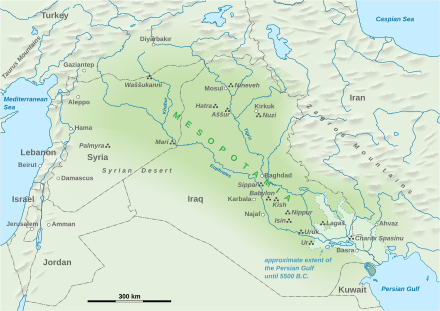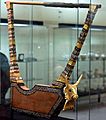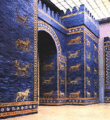Mesopotamia facts for kids
Mesopotamia (which means "land between rivers" in Greek) is a historic area in Western Asia. It's located between the Tigris–Euphrates river system, in the northern part of the Fertile Crescent. Today, this area mostly covers Iraq, Kuwait, eastern Syria, and parts of southeastern Turkey.
This region was home to some of the earliest and most powerful civilizations. The Sumerians and Akkadians (including Assyrians and Babylonians) were the main groups here. They ruled Mesopotamia from around 3100 BC, when writing first began, until 539 BC. That's when the Achaemenid Empire conquered Babylon.
Later, Alexander the Great took control in 332 BC. After he died, Mesopotamia became part of the Greek Seleucid Empire. Around 150 BC, the Parthian Empire took over. For a long time, Mesopotamia was a battleground between the Parthians and the Romans. In AD 226, the eastern parts fell to the Sassanid Persians. This division lasted until the 7th century AD, when Muslim armies conquered the region.
Mesopotamia is famous for being the place where the Neolithic Revolution started around 10,000 BC. This means it was a key area for huge changes in human history. Some of the most important inventions and ideas came from here. These include the wheel, the first crops being planted, and the development of writing, mathematics, astronomy, and agriculture.
Contents
Geography of Mesopotamia
Mesopotamia is made up of two main types of land. Northern Mesopotamia has hills and plains. It gets seasonal rains, and rivers and streams flow down from the mountains. Early people here farmed the land and used resources like timber, metals, and stone.
Southern Mesopotamia is different. It has marshy areas and wide, flat plains. Big cities grew along the rivers that flow through this region. To grow their crops, early settlers had to irrigate the land. This means they built systems to bring water from the rivers to their fields.
People and Empires
Mesopotamia has been conquered many times by different groups of people. It was the heartland of the Sumerian, Akkadian, Babylonian, and Assyrian empires. Each new group that moved into the region often adopted some of the culture, traditions, and beliefs of the people who lived there before them.
This fertile land was also conquered by Alexander the Great (332 BC), the Parthians (150 BC), the Romans, the Persian Empire, and the Arabs (7th century AD). It remains a very valuable part of the Middle East because of its rich land.
The long history of ancient Mesopotamia can be divided into several periods:
- Early Farming Times (Neolithic): This was when people first started farming and living in villages.
- Jarmo (around 7000 BC – 6000 BC)
- Early Villages and Pottery (Pottery Neolithic): More advanced farming and pottery making.
- Hassuna (around 6000 BC), Samarra (around 5700 BC – 4900 BC), and Halaf (around 6000 BC – 5300 BC) cultures.
- Copper Age (Chalcolithic): People started using copper tools.
- Ubaid period (around 5900 BC – 4400 BC)
- Uruk period (around 4400 BC – 3200 BC)
- Jemdet Nasr period (around 3100 BC – 2900 BC)
- Early Bronze Age: The first big cities and empires appeared.
- Middle Bronze Age: Important kingdoms like early Babylonia and Assyria grew.
- Early Babylonia (20th–18th century BC)
- Early Assyrian kingdom (20th–18th century BC)
- Late Bronze Age: This period ended with a big collapse across the region.
- Kassite dynasty (16th–12th century BC)
- Iron Age: Powerful empires like the Neo-Assyrian and Neo-Babylonian empires rose.
- Neo-Assyrian Empire (10th–7th century BC)
- Neo-Babylonian Empire (7th–6th century BC)
- Classical Antiquity: Control shifted to larger empires outside Mesopotamia.
- Persian Babylonia, Achaemenid Empire (6th–4th century BC)
- Seleucid Mesopotamia (4th–3rd century BC)
- Parthia, then Asuristan (3rd century BC – 3rd century AD)
- Late Antiquity: The region was divided between two major empires before the Arab conquest.
The Epic of Gilgamesh
The Epic of Gilgamesh is a very old story from ancient Mesopotamia. It's about a king named Gilgamesh and his close friend, Enkidu. Enkidu was a wild man created by the gods to stop Gilgamesh from being too harsh on the people of Uruk.
Together, Gilgamesh and Enkidu go on dangerous adventures that upset the gods. First, they travel to the Cedar Mountain to defeat Humbaba, a scary monster who guards it. Later, they kill the Bull of Heaven, which the goddess Ishtar sent to punish Gilgamesh.
The second part of the story is about Gilgamesh's sadness after Enkidu dies. He goes on a long journey to find a way to live forever. He wants to meet Utnapishtim, a hero who survived a great flood and was granted eternal life. But during his quest, Gilgamesh is told:
- "The life that you are seeking you will never find. When the gods created man they allotted to him death, but life they retained in their own keeping".
This means that humans are meant to die, and only the gods can live forever.
Related pages
Images for kids
-
Mesopotamian Marshes at night, southern Iraq; reed house (Mudhif) and narrow canoe (Mashoof) in the water. Mudhif structures have been one of the traditional types of structures, built by the Marsh people of southern Mesopotamia for at least 5,000 years. A carved elevation of a typical mudhif, dating to around 3,300 BCE was discovered at Uruk.
-
After early starts in Jarmo (red dot, circa 7500 BC), the civilization of Mesopotamia in the 7th–5th millennium BC was centered around the Hassuna culture in the north, the Halaf culture in the northwest, the Samarra culture in central Mesopotamia and the Ubaid culture in the southeast, which later expanded to encompass the whole region.
-
The Code of Hammurabi is a Babylonian legal text composed c. 1755–1750 BC. It is the longest, best-organised, and best-preserved legal text from the ancient Near East. It is written in the Old Babylonian dialect of Akkadian, purportedly by Hammurabi, sixth king of the First Dynasty of Babylon.
-
Epic of Gilgamesh, an epic poem from ancient Mesopotamia, regarded as the earliest surviving notable literature.
-
Clay tablet, mathematical, geometric-algebraic, similar to the Euclidean geometry. From Shaduppum Iraq. 2003-1595 BC. Iraq Museum.
-
The Queen's gold lyre from the Royal Cemetery at Ur. C. 2500 BCE. Iraq Museum.
-
Bronze head of an Akkadian ruler, discovered in Nineveh in 1931, presumably depicting either Sargon of Akkad or Sargon's grandson Naram-Sin.
-
Striding lions from the Processional Street of Babylon.
-
Detail of Nebuchadnezzar II's Building Inscription plaque of the Ishtar Gate, from Babylon
-
Artist's impression of a hall in an Assyrian palace from The Monuments of Nineveh by Austen Henry Layard, 1853
-
A Neo-Assyrian relief of Ashur as a feather robed archer holding a bow instead of a ring (9th-8th century BC)
-
The Black Obelisk of Shalmaneser III. The king, surrounded by his royal attendants and a high-ranking official, receives a tribute from Sua, king of Gilzanu (north-west Iran), who bows and prostrates before the king. From Nimrud
-
Contemporary artwork depicting Babylon at the height of its stature.
-
"Winged genie", Nimrud c. 870 BC, with inscription running across his midriff.
-
The Ishtar gate was constructed in about 575 BCE by order of King Nebuchadnezzar II. Pergamon Museum, Berlin
-
The walls of Babylon, in Babylon
-
Ziggurat of Ur
-
A suggested reconstruction of the appearance of a Sumerian ziggurat
See also
 In Spanish: Mesopotamia para niños
In Spanish: Mesopotamia para niños





























